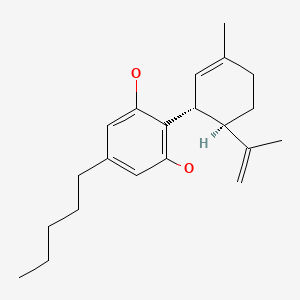Attribution Statement: LactMed is a registered trademark of the U.S. Department of Health and Human Services.
NCBI Bookshelf. A service of the National Library of Medicine, National Institutes of Health.
Drugs and Lactation Database (LactMed®) [Internet]. Bethesda (MD): National Institute of Child Health and Human Development; 2006-.
CASRN: 13956-29-1

Drug Levels and Effects
Summary of Use during Lactation
Cannabidiol is a component of cannabis. Cannabidiol has not been studied in nursing women taking the pharmaceutical product, but it has been detected in the breastmilk of some mothers who used cannabis products.[1-3] Because no published information is available with cannabidiol use as an antiepileptic during breastfeeding, an alternate drug may be preferred, especially while nursing a newborn or preterm infant.
Drug Levels
In published reports of anticonvulsant use during breastfeeding, most women were taking a combination of anticonvulsants. Some other anticonvulsants (e.g., phenytoin, carbamazepine) stimulate the metabolism of other drugs including anticonvulsants, whereas others (e.g., valproic acid) inhibit the metabolism of other drugs. Therefore, the relationship of the maternal dosage to the concentration in breastmilk can be quite variable, making calculation of the weight-adjusted percentage of maternal dosage less meaningful than for other drugs reported in LactMed.
Maternal Levels. Cannabidiol was measured in the milk of mothers who reported using cannabis and donated milk samples. Fifty mothers donated 54 samples of milk to a breastmilk repository. The median concentration of cannabidiol was 5 mcg/L (range 1.3 to 8.6 mcg/L).[2]
A physiologically based pharmacokinetic model of cannabidiol was constructed using data from 181 mothers who donated 200 samples of breastmilk to the breastmilk repository. Of these, 42% had cannabidiol concentration below the level of quantification. Maternal ingestion by oil or pipe tended to result in higher predicted concentrations as compared with joint, blunt or edible forms. The dose in infants was projected to result in exposure of fully breastfed infants of less than 1% of that in children 4 to 10 years old who were receiving the drug therapeutically for seizures.[3]
Infant Levels. Relevant published information was not found as of the revision date.
Effects in Breastfed Infants
Relevant published information was not found as of the revision date.
Effects on Lactation and Breastmilk
Relevant published information was not found as of the revision date.
Alternate Drugs to Consider
(Seizure Disorder) Carbamazepine, Divalproex, Gabapentin, Lamotrigine, Oxcarbazepine, Phenytoin, Valproic Acid
References
- 1.
- Silveira GD, Loddi S, De Oliveira CDR, et al. Headspace solid-phase microextraction and gas chromatography-mass spectrometry for determination of cannabinoids in human breast milk. Forensic Toxicol 2017;35:125-32. doi:10.1007/s11419-016-0346-5 [CrossRef]
- 2.
- Bertrand KA, Hanan NJ, Honerkamp-Smith G, et al. Marijuana use by breastfeeding mothers and cannabinoid concentrations in breast milk. Pediatrics 2018;142:e20181076. [PMC free article: PMC6317767] [PubMed: 30150212]
- 3.
- Yeung CHT, Bertrand KA, Best BM, et al. Cannabidiol exposure through maternal marijuana use: Predictions in breastfed infants. Clin Pharmacokinet 2023;62:1611-9. [PMC free article: PMC10659070] [PubMed: 37735347]
Substance Identification
Substance Name
Cannabidiol
CAS Registry Number
13956-29-1
Drug Class
Breast feeding
Lactation
Milk, Human
Anticonvulsants
Cannabinoids
Disclaimer: Information presented in this database is not meant as a substitute for professional judgment. You should consult your healthcare provider for breastfeeding advice related to your particular situation. The U.S. government does not warrant or assume any liability or responsibility for the accuracy or completeness of the information on this Site.
- User and Medical Advice Disclaimer
- Drugs and Lactation Database (LactMed) - Record Format
- LactMed - Database Creation and Peer Review Process
- Fact Sheet. Drugs and Lactation Database (LactMed)
- Drugs and Lactation Database (LactMed) - Glossary
- LactMed Selected References
- Drugs and Lactation Database (LactMed) - About Dietary Supplements
- Breastfeeding Links
- PMCPubMed Central citations
- PubChem SubstanceRelated PubChem Substances
- PubMedLinks to PubMed
- Increase of mesenchymal stem cell migration by cannabidiol via activation of p42/44 MAPK.[Biochem Pharmacol. 2014]Increase of mesenchymal stem cell migration by cannabidiol via activation of p42/44 MAPK.Schmuhl E, Ramer R, Salamon A, Peters K, Hinz B. Biochem Pharmacol. 2014 Feb 1; 87(3):489-501. Epub 2013 Dec 1.
- Abnormal cannabidiol confers cardioprotection in diabetic rats independent of glycemic control.[Eur J Pharmacol. 2018]Abnormal cannabidiol confers cardioprotection in diabetic rats independent of glycemic control.Matouk AI, Taye A, El-Moselhy MA, Heeba GH, Abdel-Rahman AA. Eur J Pharmacol. 2018 Feb 5; 820:256-264. Epub 2017 Dec 20.
- Vasodilator actions of abnormal-cannabidiol in rat isolated small mesenteric artery.[Br J Pharmacol. 2003]Vasodilator actions of abnormal-cannabidiol in rat isolated small mesenteric artery.Ho WS, Hiley CR. Br J Pharmacol. 2003 Apr; 138(7):1320-32.
- Review Cannabidiol: A New Hope for Patients With Dravet or Lennox-Gastaut Syndromes.[Ann Pharmacother. 2019]Review Cannabidiol: A New Hope for Patients With Dravet or Lennox-Gastaut Syndromes.Chen JW, Borgelt LM, Blackmer AB. Ann Pharmacother. 2019 Jun; 53(6):603-611. Epub 2019 Jan 8.
- Review Tedizolid.[Drugs and Lactation Database (...]Review Tedizolid.. Drugs and Lactation Database (LactMed®). 2006
- Cannabidiol - Drugs and Lactation Database (LactMed®)Cannabidiol - Drugs and Lactation Database (LactMed®)
- Taxonomy Links for Protein (Select 357197599) (1)Taxonomy
- eggc.vipdBI (0)BioProject
Your browsing activity is empty.
Activity recording is turned off.
See more...
